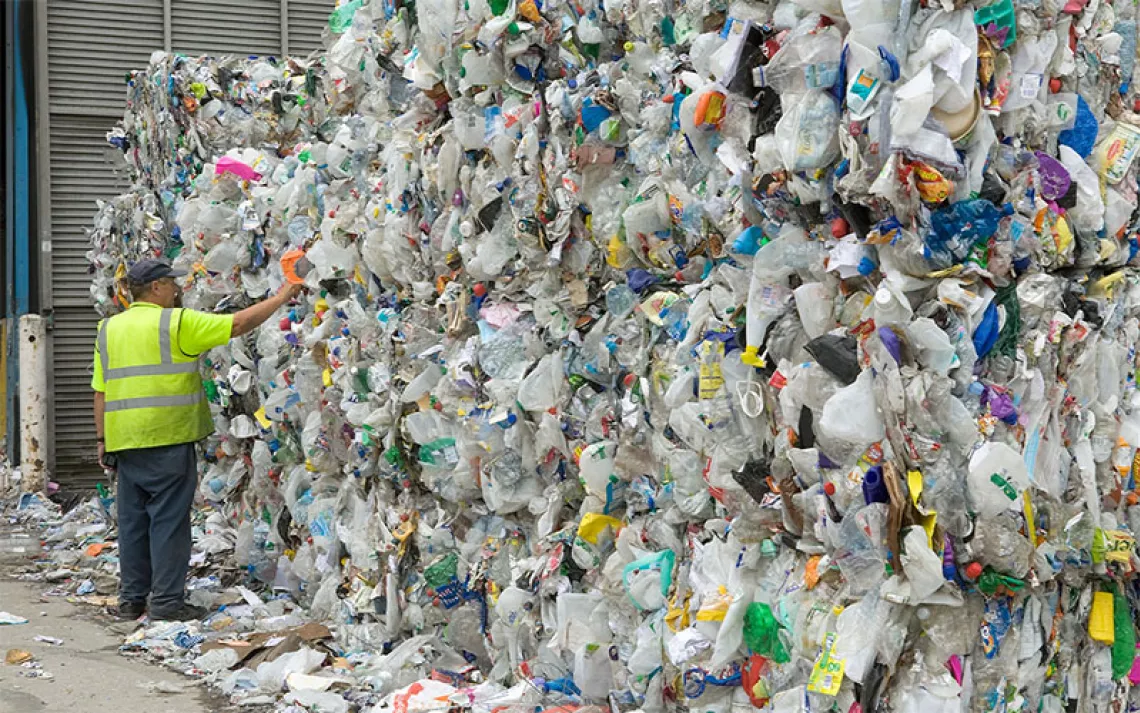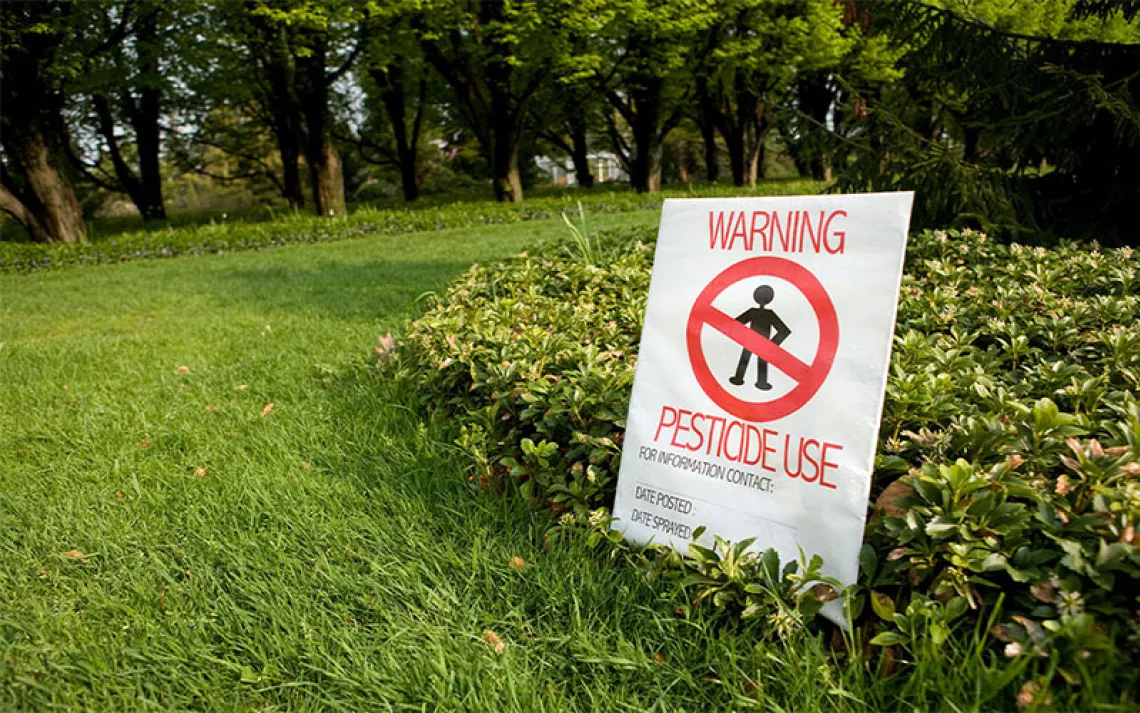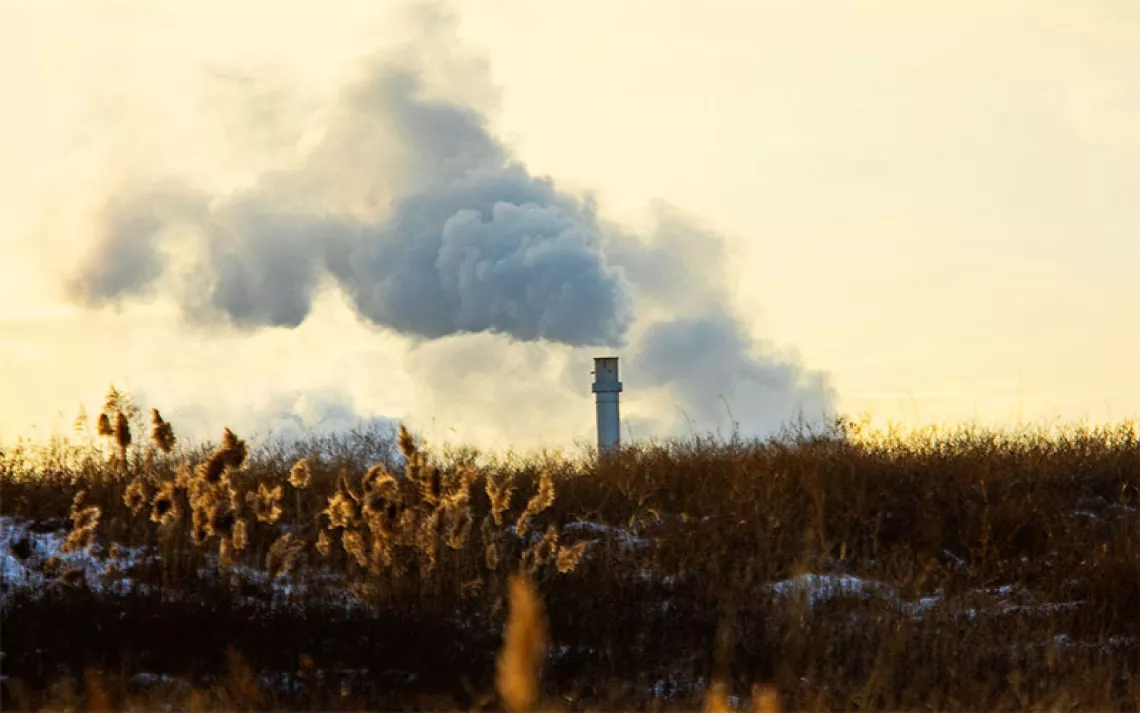Speed at What Cost?
Fluorinated ski waxes allow skiers to fly on slopes, but they can harm humans

Photo by destillat/iStock
When Jessie Diggins lunged across the finish line to win the women’s team sprint cross-country event at the 2018 Olympics, her historic victory was decided by mere centimeters. “Here comes Diggins! Here comes Diggins!” shouted the television announcer, excited by Diggins’s masterful glide. This gold medal, shared by Diggins and teammate Kikkan Randall, was Team USA’s first ever in cross-country skiing. The victory was made possible by the athlete’s smooth strides and overwhelming physical power. Equally important as Diggins’s athletic prowess, however, was her ski wax.
Skiers have been applying wax to the base of their skis for generations. Since the sport’s founding, ski waxing has been a popular way to prepare boards to move smoothly on variable surfaces. For ski technicians in the alpine and Nordic racing domains, waxing athletes' skis before competitions is a crucial process that combines both art and science. “We don’t want a fit athlete that can’t compete because the skis are bad,” Andrew Morehouse, a technician for the US cross-country ski team, told Wired in a 2018 story about the practice. “We have won some races when our wax is better.” For Morehouse and many others in the ski industry, “better” wax generally means wax that includes fluorocarbons—synthetic chemicals that pose significant environmental and health risks.
In the late 1980s, a type of high-performance wax containing fluorocarbons was introduced to the market. Now referred to as “fluoro wax,” it has become indispensable to skiers worldwide. Though pricey, its hydrophobic properties make it perfect for gliding smoothly across snow in wet conditions. By melting just small amounts of flouro wax on a ski’s base, skiers can obtain a nearly stick-free ride. “It’s the most joyous thing I’ve ever experienced,” former Middlebury College Nordic coach Andrew Gardner told Bloomberg.
Today, fluoro waxes are everywhere—from youth programs and recreational groups to Division I alpine and Nordic racing to the Olympics. While technicians for professional teams have stock rooms full of it, individuals typically order the wax online or buy it locally. Any wax labeled “HF” for high-fluorocarbon or “LF” for low-fluorocarbon contains the chemical. Those labeled “CH” for hydrocarbon do not contain fluorocarbons and therefore lack the same speedy performance benefits.
The chemistry behind fluoro wax can be confusing; the terms fluorocarbons, perfluorocarbons, PFAS, and PFCs are often used interchangeably. The type of ski wax that has raised concern contains substances commonly referred to as perfluorinated chemicals, or PFCs. The binding of fluorine atoms with carbon chains is what creates the compounds known as PFCs. The resulting molecules have liquid-repelling properties, making PFCs popular in items such as nonstick pans and rain jackets. Their persistence within the environment has, along with the broader class of PFAS, earned them the nickname “forever chemicals.”
The chemicals contained in fluoro waxes have been shown to harshly affect humans, animals, and the environment. In a 2010 study titled “Occupational Exposure to Airborne Perfluorinated Compounds During Professional Ski Waxing,” researchers studied 13 professional ski waxers to observe the effects of the chemicals they were working with. The study found elevated concentrations of the chemicals within the blood of the technicians. The researchers remarked that the effect was likely also present in the ski community as a whole, noting that a “significant larger group of amateur skiers and waxers are potentially exposed to these compounds.”
Another 2010 study by Swedish researchers found that the chemical intake that occurs when melting wax has significant health effects. While concentration levels for a certain PFC were, on average, 2.7ng/mL for a nonexposed group, ski technicians averaged a 112ng/mL concentration in their bodies during the ski season. More exposure over time led to even higher concentrations. Additional research has demonstrated that the biological alterations that these chemicals cause can pose health risks such as cancer, hormone disruption, and liver damage. Despite the use of well-ventilated waxing rooms and protective masks, the “forever chemicals” consistently find their way into the human body.
Robert Woellner, an environmental and industrial hygiene consultant at Quest Environmental in Denver, is all too familiar with the dangerous effects of PFAS. “We have been involved in a number of assessments tracking and monitoring the sources, pathways, and impacts of various fluorocarbons in the environment,” he told Sierra. He explained that laboratories across the world have recently made improvements in testing for the chemicals, as concerns about PFAS being unable to break down in the environment grow.
Although research pertaining to PFC’s effects on animals and the environment is not as extensive as studies looking at the effect on humans, Woellner confirmed that there is clear evidence that the chemicals move throughout the food web and can bioaccumulate in animals’ bodies. “Numerous studies are now finding low concentrations of PFAS in surface water and groundwater, as well as in worms, fish, birds, and mammals, including bears,” he said, concluding that the studies “have identified that PFAS are very durable and persistent in the environment.” Because these chemicals do not break down easily, they can make their way from the bases of skis to water sources and soil. The animals that inhabit these ecosystems can then experience the same type of chemical exposure as ski technicians.
As both a skier and an industrial hygienist, Woellner admits that he feels some guilt when using ski wax. He noted, however, “I understand that my wax is not the only source of PFAS being released in the environment.” He pointed to other examples such as waterproof clothing. But, as Woellner and all skiers know, wax is distributed in particularly sensitive areas of the environment, such as at the top of watersheds. “I expect that my initial or occasional waterproofing treatments of clothing do not match the frequency and volume of the waxes that I place on my skis. When PFAS are detected in mountain soils, surface waters, and animals near ski areas, then, yes, I bear some responsibility,” Woellner admitted.
In response to these findings, government agencies and some skiing organizations have begun advocating for a ban on flouro ski waxes. The EPA has begun to crack down on the ski industry in attempts to protect the world from PFCs. In an action plan published in February 2019, the EPA stated, “There is evidence that continued exposure above specific levels to certain PFAS may lead to adverse health effects.” In the winter of 2018, the EPA—using its authority under the Toxic Substances Control Act—initiated a formal review process into wax manufacturer Swix USA. Swix responded by stopping the sale of perfluorinated products directly on its website and to US retailers. Many preseason orders, however, had already shipped by that point. Fluoro wax remains present in the United States.
On the other side of the Atlantic, the European Union has devised plans to ban PFOAs, which are a subclass of PFCs that hold fluoro waxes and other products together. New regulations that will go into effect in July 2020 “will ban the sale, manufacture, and import of all products containing PFOAs.” Fluoro waxes will be illegal to buy in Europe, though it remains to be seen whether the European ski community will move to less dangerous waxing methods or push back against the rules in the name of speed.
One skiing institution that has already instituted a total ban of fluoro waxes is the Eastern Intercollegiate Ski Association (EISA), which represents NCAA skiing competitors in the East. This has inspired other local and regional wax bans. In Anchorage, Alaska, high school ski programs have called a “wax truce” due to the health risks associated with the fluorocarbon products.
The problem with local bans, however, is that they are both hard to enforce and, by definition, quite limited, since local organizations only have jurisdiction over their own races. For the EISA, this means that it can only regulate wax use in Eastern Region NCAA races—commonly referred to as “carnivals.” However, college racers only compete in a handful of carnivals a year; most races are governed by the United States Ski Association and International Ski Federation for further competition.
Chauncey Morgan, a Division I alpine racer for Colby College and a Maine Alpine Racing Association board member, said he supports wax bans. “It makes a ton of sense,” he said, “but it’s going to be nearly impossible to actually enforce.” He explained that fluoro wax provides such a massive advantage that “people are still going to use it until it’s either gone or outlawed across all races, not just carnivals.”
Tricia Mangan, a 2018 Olympian who has competed for both the US Ski Team and the Dartmouth Alpine Ski Team, echoed these sentiments. “I definitely support a ban of all fluoros because of their impact on the environment,” she told Sierra. “However, I think that the only way a ban is going to work is if they come up with a way to test for fluoros on skis. Right now, there’s no way to do that. It would just be an honor principle.” The “they” Mangan is referring to is the International Ski Federation, which oversees the professional World Cup races that she has competed in. Despite its size and reach, the federation still lacks adequate testing methods, rendering a fluoro wax ban practically useless. The reliance on an honor principal within a professional athletic circuit, Mangan believes, is “not very realistic, especially in speed races where wax can make a huge difference.” Similar to local organizations like the EISA, the International Ski Federation has a long way to go before an effective ban is a possibility.
Even passionate, speed-craving skiers like Mangan and Morgan understand that what’s at stake here is human, animal, and environmental health. Their support for a ban shows that a balancing act exists between the desire for speed and the equally important need for environmental protection. This holds true across the sport, as those with a vested interest in skiing tend to fall into both groups: avid skier and concerned environmentalist.
The call for reform from skiers at all levels hinges on effective actions from governing bodies of the ski and ski-racing industries. In Mangan’s view, this means using chemical testing to regulate dangerous fluoro waxes in a way that preserves fairness for racers. When asked what he thought of Mangan’s idea, Morgan, the Colby Alpine Team member, said, “That definitely imposes some short-term costs on the ski industry, but I think it would be worth it for everyone in this community in the long run.”
Skiers across the world understand that a sustainable future is what is needed if we want to see magical ski moments like Diggins’s 2018 Olympic win continue.
 The Magazine of The Sierra Club
The Magazine of The Sierra Club



